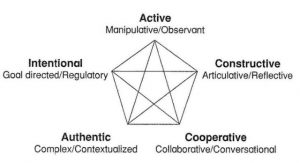I have to agree with Chris Dede and his acknowledgement of Trotter’s (1998) statement that the inclusion of technology alone does not equate to better educational outcomes. My ideal pedagogical design of a technology-enhanced learning experience for math and/or science is exactly that, enhanced. The inclusion of technology into a classroom must enhance and enrich the learning experience. As I have stated before, technology needs to be implemented in a meaningful way that will allow students to better engage and learn the information at hand.
I found this diagram, picture below, that details five different conditions of meaningful learning.

While this particular diagram does not specifically address technology in the classroom, one can certainly see the relatedness of it. Any technology that is incorporated into the classroom should fall into most, if not all, of the following categories: active, constructive, cooperative, authentic, and most importantly in my opinion, intentional. Technology Enhanced Learning Environments (TELE’s) should be purposeful at their core.
References
(Image)
Meaningful Learning – Education wired up. (2017). Retrieved 9 June 2017, from https://sites.google.com/site/educationwiredup/time-tracker
Thanks Kirsten, for sharing the diagram. It certainly does provide a concrete framework from with which we should definitely base all educational design, especially TELEs. I particularly attribute solid design to authentic learning opportunities. If students can learn a construct beyond the paper from an authentic learning engagement, then I believe we are doing justice to that student’s learning. ‘Active’ learning is another component that I agree with when it comes to incorporating technology into the classroom. It fits in well with Kozma’s ideas of empowering learning with tools to enhance the pedagogy (Kozma, 2003).
Reference:
Kozma, R. B., & Voogt, J. (2003). Technology, innovation, and educational change: A global perspective: A report of the second information technology in education study, module 2 ISTE (Interntl Soc Tech Educ.)
Hi Jocelynn,
I agree whole-heartedly that authentic learning tasks BEYOND the paper are where real learning occurs. While handouts may have some merit to them still (or do they?), for the most part, students are not engaged in their learning and ultimately, they are unable to make connections to them. Thanks for making the connection to Kozma’s (2003) ideas, you are absolutely correct!
Yes, thank you for sharing the diagram! A great framework to assess how we can utilize technology to create deeper learning experiences for our learners. Edelson (2000) discusses how teachers are struggling with how to support deeper learning and inquiry with new standards. His article speaks about how we can blend content and process together when we are designing learning activities to offer our students the best learning experience, and a deeper understanding of the big ideas and curricular competencies through technology. His framework is called the Learning-for-Use model. “Science educators are facing rapidly increasing demands. At the same time that they are
being asked to teach more content more effectively, they are being asked to devote more time to
having students engage in scientific practices” (Edeslon, 2000). It helped me to further develop my ideal TELE, especially in terms of reflection on inquiry activities.
Edelson, D. C. (2001). Learning-for-use: A framework for the design of technology-supported inquiry activities. Journal of Research in Science Teaching, 38(3), 355-385. doi:10.1002/1098-2736(200103)38:33.0.co;2-m
Thanks for sharing Edelson’s (2001) ideas regarding time vs. teaching vs. engagement. I believe that this statement can be related to all subjects and not restricted to just Science as well. The Learning-for-Use model is one educators strive for but unfortunately, as you stated, many of us are constrained by the curriculum. When we can blend as many learning expectations into one lesson/unit, we are ‘killing two birds with one stone’. Thanks for your response!
Hi Kirsten
I like the fact that you included an image in your post.
I wonder if could give an example of “meaningful learning” using the provided diagram.
A good next step might be to take the diagram and include how technology could be included.
Double check on how to write references. Where did that website get the image? Also, you did not include Trotter’s (1998) in your reference list.
Christopher
Hi Christopher,
Cooperative meaningful learning is one that I find completely invaluable if it is done properly. For instance, sometimes during group work, students who are unengaged with the content tend to take a back seat and do very little in terms of contribution. Providing meaningful, engaging cooperative tasks will help to ensure that the work load is evenly divided. Something as simple as following the 3-Part math lesson helps to engage all students and create the cooperative and collaborative classroom many teachers strive for.
1. Before (the lesson begins)
-teacher checks for prior knowledge (can be a whole-class discussion, an online poll, a google doc where students can contribute their answers, etc)
2. During (the lesson)
– students break into pairs or small groups (no larger than 4 students) to complete task (ie. give students the number 24 and ask them to come up with as many different equations as possible on chart paper)
3. After/Consolidation
-come back together as a class to discuss the different possibilities (can do a gallery walk so the other groups can actually see what answers their peers came up with)